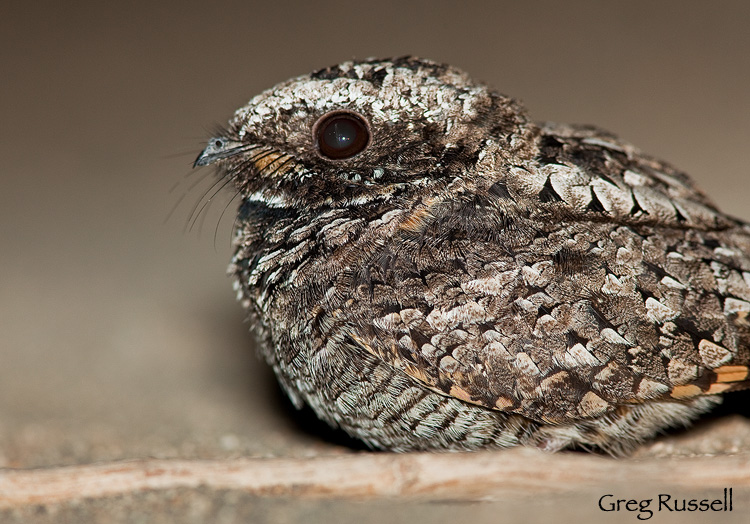After the grim nature of my last post, I thought I’d share some of the positive wildlife encounters that can be had in the desert. Last summer, a friend and I discovered huge number of common poorwills (Phalaenoptilus nuttallii) that roost on the roads in Joshua Tree National Park after dark. As a kid I remember nighthawks–another member of the Nightjar family–that would swoop through the evening sky, scooping up insects with their oversized mouths. So, the discovery of these poorwills was welcome and nostalgic.
I assume the poorwills–which are ground-dwelling birds–roost on the roads for a clear view of the sky, and the insects they are hunting. They fly upwards, grab their prey, and return to the ground fairly quickly. They can also be quite tame, when approached by a car. By getting out slowly and crawling on my belly with a short telephoto lens, I was able to get within about 7 feet of this poorwill before it flew away, letting me get a couple of intimate portraits.
One thing that’s evident here is the amazing camouflage these animals have–they blend in very well to their surroundings, making such an open roost probably quite safe. In addition to that, you can see the large eyes (great night vision) and “feelers” around the mouth, to help locate prey in the very immediate vicinity.
With summer approaching, keep an eye out for these charming birds on the roads!



Thanks for sharing and introducing me to the poorwill great shots. Walt C.
Well done, Greg! I find nightjars really appealing birds. There are a couple of camps on the Middle Fork of the Salmon where the ponderosa groves just come alive at dusk with hundreds of nighthawks. I always loving staying there!
Thanks for the comments, guys! All of the nightjars are really charming birds…and they can be amazingly confiding if you find the right one(s).
Definitely a more upbeat post, Greg. Nice intimate portrait…love those huge eyes. A slow and nonthreatening approach works great.
Thanks for sharing the enjoyable experience.
I remember Whip O’ Wills from my early childhood. But the most amazing experience with the poorwills was driving back from the Eureka Sand Dunes one night. The road was just covered with them. It was slow going for several miles as they just didn’t seem to understand that a large moving vehicle was dangerous.
I think they use the roads as a way to ambush insects just after nightfall. The roads are radiating heat as the surrounding areas are cooling rapidly and this attracts the insects.
Love the images.
Greg….
Very nice macro photography! I agree that during summer, there are a lot of interesting subjects that could be use for your photos. But now that summer’s almost over, I am still on the look out for birds and other creative stuff! Thanks for that very inspring post!
Very cool shot, Greg. I love the many layers and textures of the feathers.
Sharon
Brilliant, as you know I was a bird nut before I suffered a terminal dose of landscape fever. Even yesterday I took a break from shooting the sunset to shoot some Sanderlings that were running on the beach.
This is a really interesting behaviour thread… Brilliant images..
Thanks, Alister! Its funny you mention it, because when I began as a photographer, I wanted to be a bird photographer. However, the landscape bug bit me hard (and the long lenses I needed were out of a graduate student’s salary) and I haven’t really looked back. I still shoot birds occasionally, but am happy with the path I’ve taken.
Wonderful shots of these fascinating birds!
Thank you Pat! They really are cool birds.